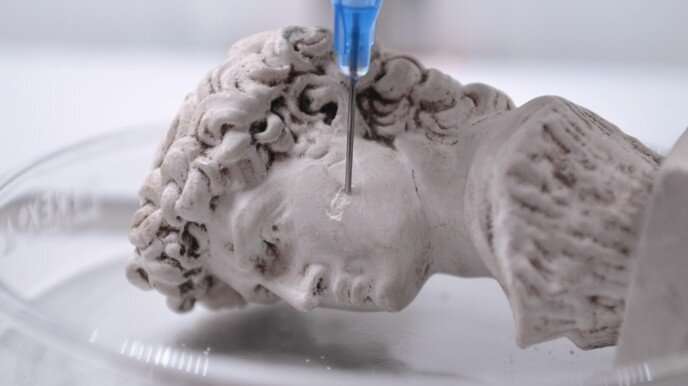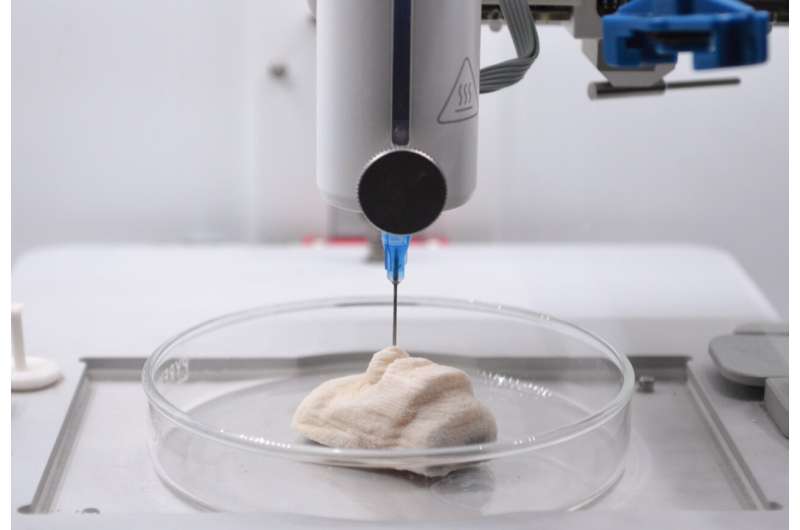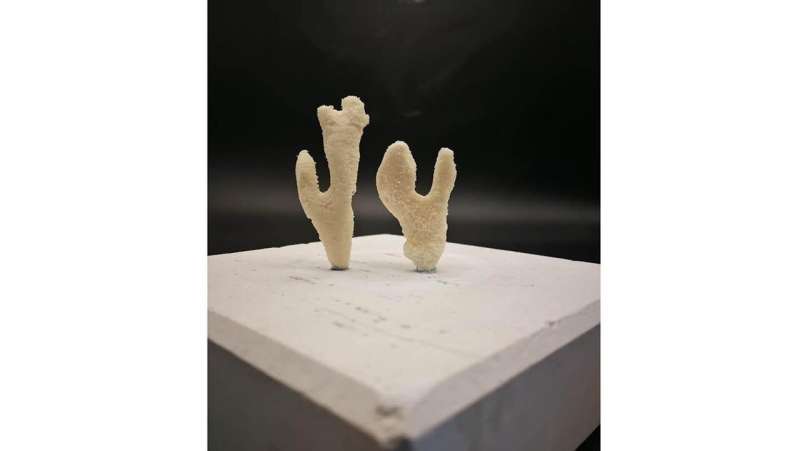
EPFL researchers have published a method for 3D-printing an ink that contains calcium carbonate-producing bacteria. The 3D-printed mineralized bio-composite is unprecedently strong, light, and environmentally friendly, with a range of applications from art to biomedicine.
Nature has an extraordinary knack for producing composite materials that are simultaneously light and strong, porous and rigid—like mollusk shells or bone. But producing such materials in a lab or factory—particularly using environmentally friendly materials and processes—is extremely challenging.
Researchers in the Soft Materials Laboratory in the School of Engineering turned to nature for a solution. They have pioneered a 3D printable ink that contains Sporosarcina pasteurii: a bacterium which, when exposed to a urea-containing solution, triggers a mineralization process that produces calcium carbonate (CaCO3). The upshot is that the researchers can use their ink—dubbed BactoInk—to 3D-print virtually any shape, which will then gradually mineralize over the course of a few days.
“3D printing is gaining increasing importance in general, but the number of materials that can be 3D printed is limited for the simple reason that inks must fulfill certain flow conditions,” explains lab head Esther Amstad. “For example, they must behave like a solid when at rest, but still be extrudable through a 3D printing nozzle—sort of like ketchup.”
Amstad explains that 3D printing inks containing small mineral particles have previously been used to meet some of these flow criteria, but that the resulting structures tend to be soft, or to shrink upon drying, leading to cracking and loss of control over the shape of the final product.

“So, we came up with a simple trick: instead of printing minerals, we printed a polymeric scaffold using our BactoInk, which is then mineralized in a second, separate step. After about four days, the mineralization process triggered by the bacteria in the scaffold leads to a final product with a mineral content of over 90%.”
The result is a strong and resilient bio-composite, which can be produced using a standard 3D printer and natural materials, and without the extreme temperatures often required for manufacturing ceramics. Final products no longer contain living bacteria, as they are submerged in ethanol at the end of the mineralization process.
The method, which describes the first 3D printing ink that uses bacteria to induce mineralization, has recently been published in the journal Materials Today.
Patching up art, coral reefs, or bone
The Soft Materials Lab’s approach has several potential applications across a broad range of fields, from art and ecology to biomedicine. Amstad believes that the restoration of artworks could be greatly facilitated by BactoInk, which can also be directly injected into a mold or target site—a crack in a vase or a chip in a statue, for example. The ink’s mechanical properties lend it the strength and shrinkage resistance necessary to repair a work of art, as well as prevent further damage during the restoration process.

The method’s use of only environmentally friendly materials, and its ability to produce a mineralized biocomposite also makes it a promising candidate for building artificial corals, which can be used to help regenerate damaged marine reefs. Finally, the fact that the biocomposite’s structure and mechanical properties mimic those of bone could potentially make it interesting for future biomedical applications.
“The versatility of the BactoInk processing, combined with the low environmental impact and excellent mechanical properties of the mineralized materials, opens up many new possibilities for fabricating lightweight, load-bearing composites that are more akin to natural materials than to today’s synthetic composites,” Amstad says.
More information:
Matteo Hirsch et al, 3D printing of living structural biocomposites, Materials Today (2023). DOI: 10.1016/j.mattod.2023.02.001
Citation:
3D printing with bacteria-loaded ink produces bone-like composites (2023, February 23)
retrieved 23 February 2023
from https://techxplore.com/news/2023-02-3d-bacteria-loaded-ink-bone-like-composites.html
This document is subject to copyright. Apart from any fair dealing for the purpose of private study or research, no
part may be reproduced without the written permission. The content is provided for information purposes only.
For all the latest Technology News Click Here
For the latest news and updates, follow us on Google News.
